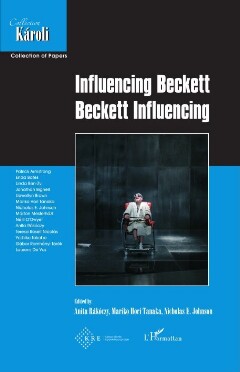Oldal 40 [40]
THE THEATRICALIZATION OF ENDGAME...
to draw his own highly cubist scenography for his play, that strongly resembles
a pictorial composition of horizontals and verticals. Amidst the greyness of the
world, the blue left window is the sea, and the red right window the earth.
Beckett considers Geer’s paintings shadowless and weightless, creating a
universe in which everything is constantly in motion. In his description of
Geer’s art we can See the very crux of what Endgame is about, a play about the
end that never ends: “All ends, endlessly.””*
I would suggest that the cubist poetics that Endgame has in common with
these paintings implies a decentralized way of looking that radically changes
one’s ego-conscious subjectivity in relation to the environment. Along with
other avant-garde movements during the first half of the twentieth century, and
in the wake of the emergence of psychoanalysis, the self is subjected to a process
of fragmentation. Cubism too develops as a style where the autonomy of the
self is perceived as an illusory Gestalt. Hence, as a result the optical illusion of
three-dimensionality yields to the flatness of the canvas without distinction
between foreground and background. These ideas also lie at the foundation of
the geometric paintings of this other Dutch painter, Piet Mondrian, probably
the most famous cubist internationally. Lines do not exist in reality, he argued,
but only set against a specific background does an image jump forward from
the lines in which our mental map immediately recognizes certain objects.
Wishing to bypass this mentally generated but delusive hierarchy of background
and foreground, Mondrian started working on compositions of colored areas
where the illusion of the existence of lines is cancelled out. Contours only exist
in the perception of overlapping areas. By not giving in to the shortcut by which
the human brain deceives us in the automatic recognition of objects in a few
lines, Mondrian aims at achieving a higher reality. It amounts to a liberation of
the mind that reveals a deeper mental reality.
Mondrian was a contemporary of the Danish Gestalt psychologist Edgar
Rubin, who revealed the working/tricking of the mind with drawings from
which emerged two distinct images, depending on the viewer’s perspective.
With his figure-ground constellations, such as the famous vase/face drawing,
he points out that distinguishing the figure from the background is crucial in
the attribution of meaning.
Consequently, the distinction between foreground and background is
a matter of perception based on mental assessments that might put us on
the wrong track. It is this awareness that Endgame shares with cubist artists
such as Mondrian and later Geer van Velde. It also presents itself in the
geometrical precision on which Beckett insists so meticulously in this play,
and by extension in his whole oeuvre. From the very beginning of the play, its
universe is measured in Clov’s clownish style:
23 Ibid., 128; my translation.
+ 39 +

